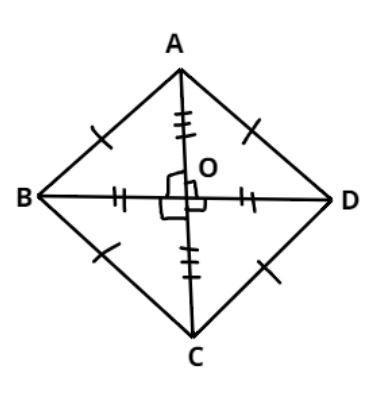
If the diagonals of a quadrilateral bisect each other at right angles, then it is a
Answer
536.1k+ views
Hint: In this Question first draw the diagram it will give us a clear picture what we have to prove and diagonals of this quadrilateral bisect each other at right angles (i.e. it cuts the diagonals into two equal parts) later on apply the property of Pythagoras Theorem so, use these concepts to reach the solution of the question.

Let ABCD be a quadrilateral as shown above.
And it is given that the diagonals of this quadrilateral bisect each other i.e. it is perpendicular to each other, (i.e. it cuts the diagonals into two equal parts).
So in triangle AOB apply Pythagoras Theorem
Now from figure
From equation (2)
Now from equation (2)
Similarly,
Now from equation (3), (4), (5) and (6)
AB = BC = CD = DA
Therefore all the sides of a quadrilateral becomes equal and the diagonals bisect at right angle,
Which is the condition of rhombus.
So, the given quadrilateral whose diagonals bisect each other at right angles is a rhombus.
Note: In such types of questions the key concept we have to remember is that always recall the property of rhombus which is in a rhombus all sides are equal and its diagonal always bisect each other at right angles, then we prove this property for the given quadrilateral whose diagonals bisect at right angle, by using the property of Pythagoras Theorem as above and simplify, we will get the required answer.

Let ABCD be a quadrilateral as shown above.
And it is given that the diagonals of this quadrilateral bisect each other i.e. it is perpendicular to each other, (i.e. it cuts the diagonals into two equal parts).
So in triangle AOB apply Pythagoras Theorem
Now from figure
From equation (2)
Now from equation (2)
Similarly,
Now from equation (3), (4), (5) and (6)
AB = BC = CD = DA
Therefore all the sides of a quadrilateral becomes equal and the diagonals bisect at right angle,
Which is the condition of rhombus.
So, the given quadrilateral whose diagonals bisect each other at right angles is a rhombus.
Note: In such types of questions the key concept we have to remember is that always recall the property of rhombus which is in a rhombus all sides are equal and its diagonal always bisect each other at right angles, then we prove this property for the given quadrilateral whose diagonals bisect at right angle, by using the property of Pythagoras Theorem as above and simplify, we will get the required answer.
Recently Updated Pages
Master Class 11 Economics: Engaging Questions & Answers for Success

Master Class 11 Business Studies: Engaging Questions & Answers for Success

Master Class 11 Accountancy: Engaging Questions & Answers for Success

Questions & Answers - Ask your doubts

Master Class 11 Accountancy: Engaging Questions & Answers for Success

Master Class 11 Science: Engaging Questions & Answers for Success

Trending doubts
A boat goes 24 km upstream and 28 km downstream in class 10 maths CBSE

Why is there a time difference of about 5 hours between class 10 social science CBSE

The Equation xxx + 2 is Satisfied when x is Equal to Class 10 Maths

What is the full form of POSCO class 10 social science CBSE

Change the following sentences into negative and interrogative class 10 english CBSE

Discuss the main reasons for poverty in India




